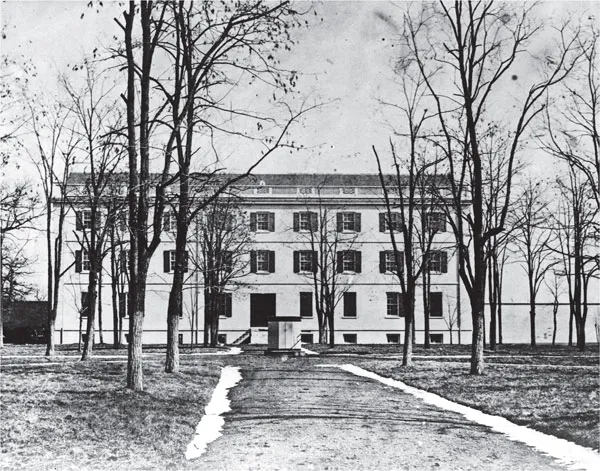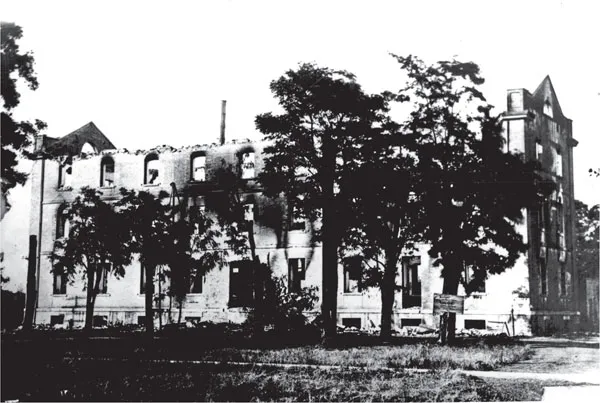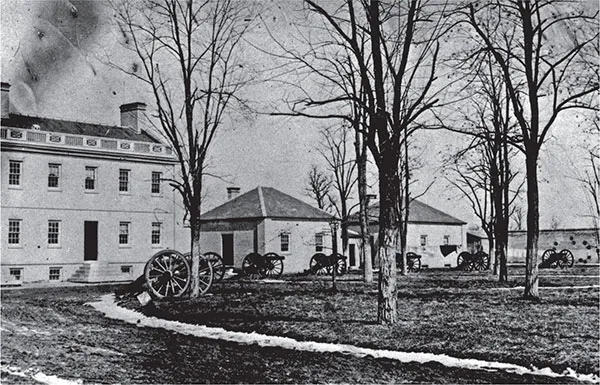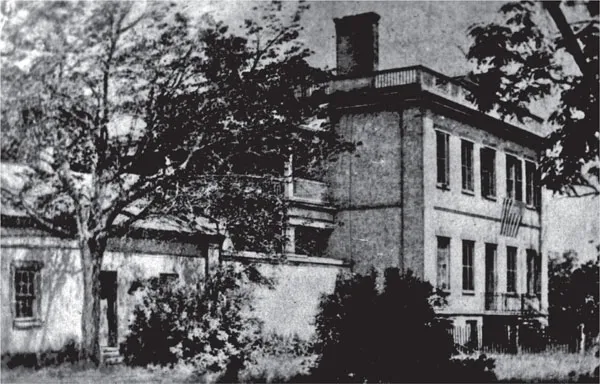![]()
1
THE ARSENAL’S WALLS HAVE FALLEN
One of the most important events to ever happen to the Dearborn area was its selection in 1832 by the federal government as the site for the building of a United States Arsenal. Historians have proposed three reasons as to why the arsenal was built in what was then a community by the name of Dearbornville. Some historians have proposed that the selection had something to do with potential migration of new settlers from the east and possible problems with Native Americans in the old Northwest Territory. It has also been suggested that Lewis Cass, who in 1832 was the secretary of war and had served as the first territorial governor, had something to do with its placement because of his ties to the area. And still others have argued that the Detroit Arsenal was simply moved west to protect the growing population in Detroit from the explosive materials that the arsenal housed.
Whatever the reason or reasons may have been for its placement, the decision transformed the area from a farming center to a mixture of farming, industry and military. The work of building the facility attracted locals and those from other areas who could engage in the occupations of brickmaker or tradesman. The 1839 Gazetteer of the State of Michigan contains an apt description of how the complex was organized and of the surrounding community, as well as the buildings that were erected and the function they would serve:
The main function of the arsenal was to store, develop, manufacture, test, repair and provide arms and ammunition to what was then known as the western frontier. During the Civil War, it was used as a training center for recruits and as a rendezvous point to muster soldiers to the South. The Detroit Arsenal at Dearbornville operated for forty-two years, until 1875, when Congress decided it was no longer useful. At that point, it passed into the hands of the Interior Department and was subdivided into lots and the land and buildings sold.
During its operation, the eleven buildings of the arsenal each had a unique purpose. In 1832, Lieutenant Joshua Howard, serving at the present arsenal—which was down in Detroit on Jefferson Avenue—was given the responsibility of building the new installation. Much of the building materials arrived via steam ferry traveling up the Rouge River from the Detroit River. At first, Howard found navigation of the Rouge to be extremely difficult, and he spent $300 to improve the river. An additional $200 was spent to make improvements to the road that led from the boat landing to the arsenal site.
In 1833, construction began on the first building, the armory. When the cornerstone was laid, it contained a silver plate with a long inscription, which read, in part, “The site of this Arsenal was determined in 1832, Michigan being then a Territory and this spot a wilderness. The grounds were prepared in the Spring of 1833 and the cornerstone was laid the 30th of July the same year.” The plate also mentions well-known names to the people of the area that can still be seen and heard today. These are names that appear on street signs, buildings and as the namesake for schools, cities and counties: Major General Alexander Macomb, Honorable Lewis Cass and General Andrew Jackson. In two months, forty-five tons of stone were transported to the arsenal site as a foundation for the armory. Two area brickmakers, Titus Dort and John Cahoon, supplied thousands of bricks for the construction of all of the arsenal structures. In addition to brickmakers, stonemasons and carpenters were also hired for the tasks that needed to be completed. And because of its durability, slate was brought in from New York to be used for the roof of each structure. The arsenal buildings were the first structures in Michigan to have slate roofs.
The largest of the arsenal structures, the armory was used to store ordnance equipment and quartermaster supplies. After the arsenal closed, it served as a civic center and, in 1899, was converted into the Arna Woolen Mills. A fire destroyed the structure in 1910. Dearborn Historical Museum.
The armory was the largest of all of the arsenal buildings and served as a storehouse for ordnance equipment and quartermaster supplies. The armory also served as a social center for military and community events. Around the year 1877, after the building had ceased to be an armory and the arsenal had closed, the building was converted into a community civic center called Liberty Hall. Activities such as dancing, roller skating, dramatic plays, lodge meetings and other functions were held there, and the structure had become important to the area’s population as a community center. Then, in 1899, the building was converted into Arna Woolen Mills, a plant that made coats and robes. A fire caused by a lightning strike destroyed the 120-foot structure beyond repair in 1910. Residents that were present at the time of the fire claimed that the fire burned and smoldered for about twenty days. Six homes were constructed from the salvaged bricks on Garrison Street near Monroe Street and three of these homes still stand today. After the fire, the last owner of the building, Herman Kalmbach, came upon the silver plate placed in the cornerstone mentioned earlier. The plate remained in his family until 1975, when it was donated to the Dearborn Historical Museum. In 1964, the Dearborn Historical Museum excavated a portion of the foundation and unearthed artifacts; they can be viewed at the museum.
The sutler’s shop was an early post exchange where personal items such as toiletries were sold to the arsenal soldiers. The shop was the equivalent of today’s army post exchange. In the early days, each army installation was regularly visited by a sutler, a man who traveled from post to post with an inventory of supplies that soldiers could purchase, such as soap, toothpaste, shaving cream, candy, tobacco, sewing kits, towels, stationery and even trinkets to send home. This was a very popular place on payday. The structure still stands today, but it has been altered. After the arsenal was closed and the buildings were put up for auction, it was used as a private residence and is now used as part of a doctor’s clinic on the northeast corner of Garrison Street and Monroe Street. Little is known about the guard house, the enlisted men’s barracks and the surgeon’s quarters. It is known that during the years following the closing of the arsenal, they were each used as residences. But all three were razed in 1892 for the erection of the Dearborn Public School.
Here are two former arsenal structures pictured in 1902, the armory and the commandant’s quarters. By this time, the Arna Woolen Mills Company had converted the armory to a production company where imitation buffalo robes and blankets were made. Dearborn Historical Museum.
What had become the Arna Woolen Mills (served as the armory during its arsenal days) was struck by lightning and destroyed in 1910. Dearborn Historical Museum.
The sutler’s shop served as the post exchange where personal items like toiletries were sold to arsenal soldiers. Pictured here in 1934, the structure served as a private residence for awhile. It still stands today, albeit in an altered state as part of a doctor’s office. Dearborn Historical Museum.
By the summer of 1833, Dort had built a kiln on the arsenal premises, making it much more convenient to supply bricks for the remaining structures that needed to be built. By November of that year, Dort was making bricks to be used in the building of the officers’ quarters (later known as the commandant’s quarters) the next spring. The commandant’s quarters served as home to nineteen commandants during its time of service. Colonel Joshua Howard, who had a long and distinguished military career, was not only the officer in charge when the arsenal was under construction, but he was also appointed the first commandant of the facility. The structure served as a center of social and cultural activities in the area until 1875. After the arsenal closed, the structure was used in a number of capacities: a multi-unit dwelling, a jail, a courthouse, the first local library, township and city offices, a school, church activities and a police station. In 1950, the building was dedicated as the City of Dearborn’s first historical museum. Today, sitting prominently at Michigan Avenue and Monroe Street, it holds the distinction of being the oldest building in Dearborn still standing on its original site. It is still a museum today and is open to the public. It has undergone several restorations and is used to teach visitors what life was like in the area in the mid-nineteenth century. There are a number of period rooms where visitors can get a better feel for a bygone era. The State of Michigan considers this structure to be one of the seven most significant buildings in the state, and it is listed in the National Register of Historic Places.
Shown from left to right in 1868 are the barracks, the guard house and the sutler’s shop. The barracks and the guard house were razed to make room for a school that was built at the corner of Garrison and Monroe Streets. Dearborn Historical Museum.
The structure that served as the arsenal office stood very close to the commandant’s quarters, and after the complex closed, it was used as a residence and a harness maker’s shop by Herman Blankertz. His business began in 1894. Blankertz then purchased an old feed shop and moved his operations to 22064 Michigan Avenue in the early 1900s when the building that had served as the arsenal office, his home and harness shop was torn down to extend Monroe Street north from Michigan Avenue.
In the 1880s, a two-story structure was erected between what had been the carpenter’s and blacksmith’s shops. It was used as a lumber mill, a canning company, an auto repair company, the Detroit-Dearborn Motor Car Company, a machine shop and a paint shop. Of particular interest was the establishment of the Detroit-Dearborn Motor Car Company in 1909. History has shown that long-lasting success in the automobile industry has been limited to only a handful of companies. Nine investors risked a small fortune on the first automobile company in Dearborn. The company’s emblem was red, white and blue, and the slogan was “Cars of Class.” In terms of creating models for the company, two designs were developed, including a two-door touring roadster called the Nike and a four-door touring torpedo called the Minerva. The former blacksmith and carpenter shops of the arsenal were used to set up a main office and factory. Within a year, the first automobile was completed, giving the Detroit-Dearborn Motor Car Company the distinction of having produced the first automobile in Dearborn, seventeen years before Ford Motor Company. In the end, 110 vehicles were produced, but due to mounting debt and mismanagement of the company’s resources and supplies, it went out of business. Today, this entire structure has been lost to history, as the buildings were razed in 1946. The bricks were purchased by Andy Palmer to build what became a very popular establishment known as Andy Palmer’s Military Inn, which was located at Telegraph and Warren.
The arsenal office (left) and commandant’s quarters (right) as they looked in 1890. After the arsenal closed, the house was used as a multi-person dwelling, a jail, a courthouse, the first local library, township and city offices, a school, church activities and a police station. Today, it tells the stor...






